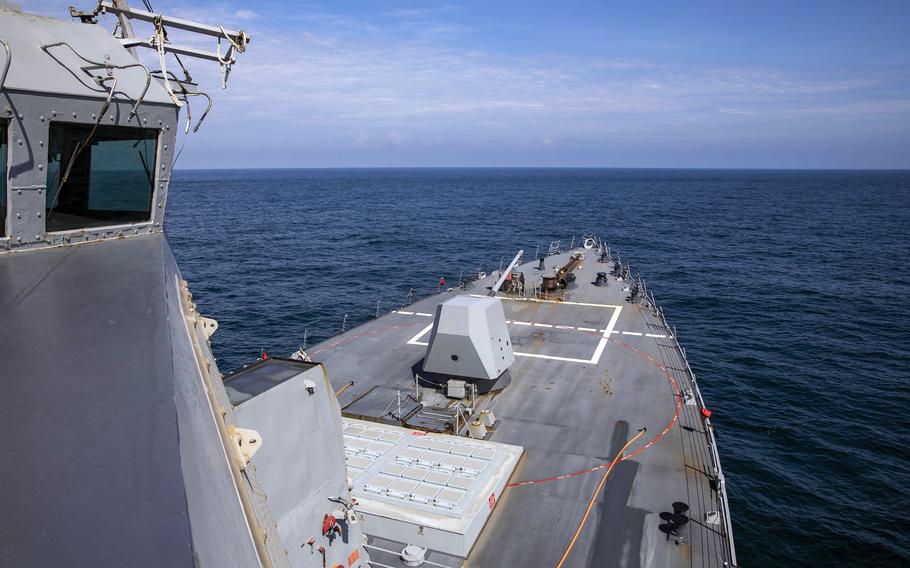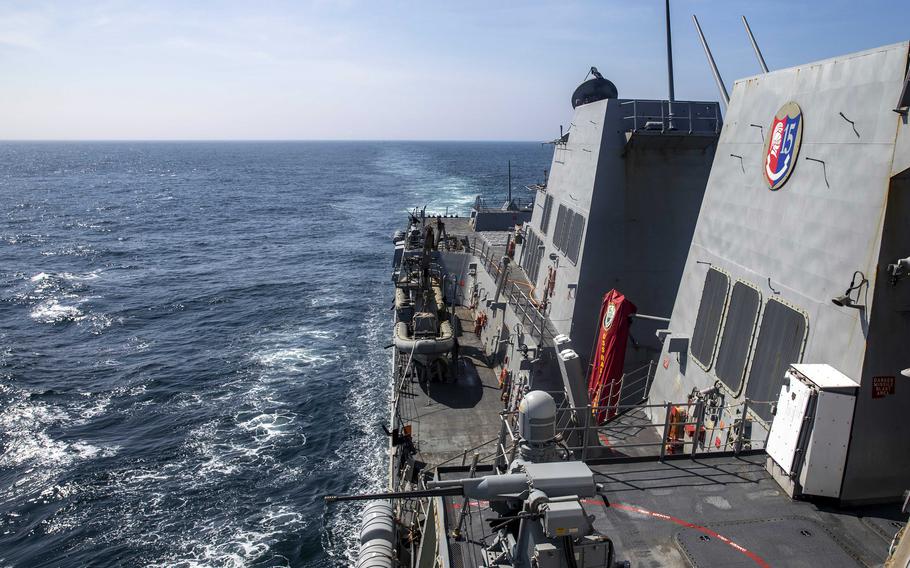
The guided-missile destroyer USS Ralph Johnson steams through the Taiwan Strait, Thursday, Aug. 22, 2024. (Jamaal Liddell/U.S. Navy)
A U.S. Navy guided-missile destroyer steamed through the Taiwan Strait on Thursday, the Navy’s first transit of the waterway in months and the fourth this year.
The USS Ralph Johnson went northeast through the strait, entering from the South China Sea and exiting in the East China Sea “to demonstrate the United States’ commitment to upholding lawful use of the sea for all nations as a principle,” U.S. 7th Fleet spokeswoman Lt. j.g. Sarah Merrill told Stars and Stripes by email Thursday.
The U.S. routinely sends warships, and, less frequently, aircraft through the 110-mile-wide channel that separates mainland China from the island of Taiwan.
“Ralph Johnson’s transit through the Taiwan Strait demonstrates the U.S. commitment to a stable, free and open Indo-Pacific,” Merrill wrote. “The U.S. military flies, sails and operates anywhere international law allows.”

The guided-missile destroyer USS Ralph Johnson steams through the Taiwan Strait, Thursday, Aug. 22, 2024. (Jamaal Liddell/U.S. Navy)
Beijing views Taiwan, a functional democracy, as a breakaway province that “does not qualify for sovereign status,” Chinese Foreign Ministry spokesman Lin Jian said July 31, and that must be reunified with the mainland, by force if necessary.
While the Navy typically says the trips are intended to uphold “freedom of navigation for all nations as a principle,” Beijing views them as provocative.
China’s Eastern Theater Command said it “organized naval and air forces” to monitor the Ralph Johnson’s trip, which was “publicly hyped up” by the U.S., spokesman Col. Xi Li wrote on the Weibo social media website.
“The theater troops are always on high alert and resolutely defend national sovereignty and security and regional peace and stability,” he wrote.
Merrill did not specify whether the Ralph Johnson encountered any Chinese forces in the strait but said “U.S. military vessels and aircraft routinely interact with foreign warships and aircraft while operating throughout the region.”
The Canadian frigate HMCS Montreal made a similar passage July 31, according to a post that day by Canadian Joint Operations Command on social platform X.
“Our activities promote peace, resilience, and security in the #IndoPacific,” the post states.
The U.S. Navy last sent a warship, the guided-missile destroyer USS Halsey, through the strait on May 8. Beijing at the time issued its own statement within an hour of the 7th Fleet’s announcement and again alleged the U.S. had “publicly hyped” the situation. China also scrambled naval and air forces to monitor the vessel, it said.
A P-8A Poseidon flew over the strait in May, while the guided-missile destroyer USS John Finn made two additional transits on March 5 and Jan. 24.